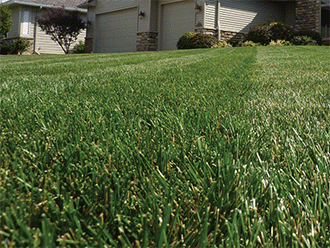By Richard Jauron

Summer weather still has Iowa in its grip, but it’s never too early to think about getting lawns and landscapes ready for spring. Fall is a perfect time to prepare lawns for the upcoming year with seeding, aeration and fertilization.
ISU Extension and Outreach horticulturists can help answer questions regarding lawns and making them as beautiful as possible. To have additional questions answered, contact the ISU Hortline at 515-294-3108 or hortline@iastate.edu.
When is the best time to sow grass seed?
Mid-August to mid-September is the best time to seed new lawns and overseed existing lawns in Iowa. A late summer seeding has several advantages over spring seeding. The seeds of cool-season grasses germinate quickly in the warm soil of late summer. The warm days and cool nights of early fall promote rapid turfgrass growth. The growing grass also has less competition from weeds as few weed seeds germinate in late summer or fall.
When purchasing grass seed, choose a high quality seed mix that is best adapted to the site. In sunny areas, Kentucky bluegrass is the best choice. Select a seed mix that contains at least three bluegrass cultivars. Use a mixture containing Kentucky bluegrass, perennial ryegrass, and fine-leaf fescues in partially shaded areas. The fine-leaf fescues (creeping red fescue, hard fescue, chewings fescue, etc.) are the best grasses for shady locations.
When is the best time to fertilize a lawn?
September, late October/early November (after the grass has stopped growing), and spring are the best times to fertilize lawns in Iowa. The number of applications depends on the desires or expectations of the homeowner, soil type, cultural practices and other factors.
ln September and late October/early November, fertilize at a rate of 0.75 to 1.0 pound of nitrogen per 1,000 square feet. In spring, apply 0.5 to 0.75 pound of nitrogen per 1,000 square feet.
When should I aerate my lawn?
September is an excellent time to aerate lawns growing in heavy, clay soils and those subject to heavy foot traffic. Aeration relieves soil compaction, improves water and nutrient movement in the soil, and prevents thatch accumulation.
Aerate lawns with a core aerator. Core aerators have hollow metal tubes or tines that remove plugs of soil. Avoid spike-type devices that simply punch holes (compacting the soil) in the ground. Remove soil cores that are approximately three-fourths of an inch in diameter and three inches long. For best results, aerate lawns when the soil is moist.
Avoid aeration when soils are dry or wet. The tubes or tines will not be able to penetrate deeply when the soil is dry and may get plugged with soil when the soil is wet. Lawns that are properly aerated should have 20 to 40 holes per square foot. Since most core aerators won’t remove the proper number of holes with a single pass, several passes are often necessary.
Source:iastate.edu